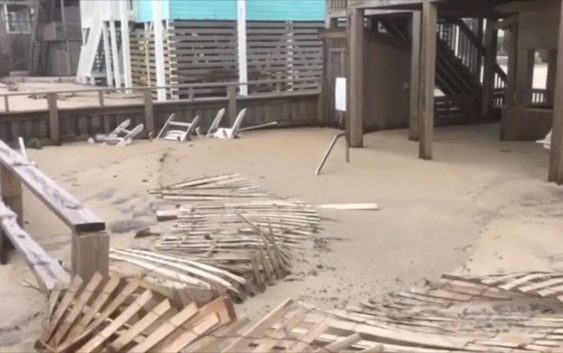- Small plane bound for Jamaica with hurricane relief supplies crashes in Florida neighborhood
- Ask the Meteorologist: Did a tornado hit Johnston County Saturday night?
- Demolition begins on flood-damaged homes in Stoney Creek as neighbors await relief
- NC Office of State Fire Marshal aiding in Hurricane Melissa relief efforts
- U.S.-based aid groups rush to get supplies into storm-battered Jamaica after Hurricane Melissa
After hurricanes hit the NC coast, don’t rebuild – retreat

Way back in 1989, a group of us who were interested in coastal management watched with fascination as Hurricane Hugo approached the shores of the Carolinas. Like everyone else, we worried about the damage it might inflict. Nevertheless, we thought progress might also result. After all, it made no sense for people to rebuild costly homes and businesses right next to eroding shorelines after other buildings had been destroyed in the same locations. We believed, naively, that Hugo might help bring common sense to coastal development.
Well, the hurricane hit, lots of damage occurred, and for a while we thought surely things would now change. We were completely wrong. Instead of leading to safer and more sensible ways of living with a barrier island coast, the storm was followed by a coastal building boom. Damaged or destroyed buildings were replaced with bigger and “better” buildings. Mom-and-pop beach cottages were replaced by large, multi-story and multi-bedroom buildings suitable for bringing in high rental fees.
What was happening at the coast was nothing less than urban renewal supported by taxpayers paying many millions of dollars to nourish the beaches and subsidize federal flood insurance – two practices that strongly encourage hazardous development.
Since Hugo, coastal urban renewal has followed other Carolina hurricanes, such as Bertha, Fran and Floyd. If this trend continues into future decades, we will have a densely packed urban shoreline with tall buildings lining our barrier islands, a la Fort Lauderdale. How ironic that destructive hurricanes lead to intensified beach development with larger structures.
Instead, why not learn from our hurricane experiences by curbing development, rather than rebuilding? No real effort by the North Carolina government, in particular, is being made to halt development at the coast. In fact, just the opposite is taking place. New bridges, roads and ferry service are improving access to island communities. Shopping centers that would do small cities proud provide a startling sight on dynamic barrier islands. Beachfront houses continue to be permitted on shorelines held in place only by beach nourishment. Three-story McMansions abound.
All of this is happening at a time when the sea level is rising. The climate is changing. Storms are expected to become bigger and more severe. More rainfall can be expected and beach erosion will increase dramatically in coming decades, which means that beach residents will want to have their beaches replenished more often.
And, as the artificial beaches become unstable and out of equilibrium with the changing sea level, their lifespan will decrease and sand will need to be added again and again. Thus, beach nourishment, already costing millions of dollars per mile, will increase considerably in cost.
By the year 2100, the sea level is expected to rise at least 3 feet. By that time, with the sea level rise accompanied by intensifying storms, much of the development on Carolina barrier islands will be destroyed.
The only way we can reduce the damage that will be caused by future storms and the rising sea is to stop urban renewal at the coast. We can do this by not replacing buildings that have been demolished or damaged by storms or shoreline erosion. We can move some buildings back or even off the islands to the mainland, although today’s high rises and multi-story homes will be difficult to move. Buildings that are in great danger can be demolished. Money that would have been spent on beach nourishment and storm recovery could be used for government buyouts and the removal of houses, as we’ve seen in New Jersey and Staten Island.
Now, in the aftermath of Hurricane Florence, is a very good time to start taking advantage of these options. Forward thinking is needed to stop coastal urban renewal and save our beaches.
Orrin H. Pilkey is James B. Duke Professor Emeritus of Earth Sciences at Duke University’s Nicholas School of the Environment and the author of numerous books about coastal geology.